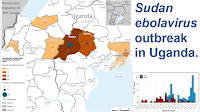On 2 June 2023, the Ministry of Health of the United Republic of Tanzania declared the end of its first documented outbreak of Marburg Virus Disease, according to a press release issued by the World Health Organization on 2 June 2023. Between 21 March and 31 May, a total of nine cases (eight laboratory-confirmed and one probable) were reported in Tanzania. All cases were reported from Bukoba district, Kagera region. A total of six deaths (a case fatality ratio of 67%) were reported during the outbreak. The declaration was made 42 days (twice the maximum incubation period for Marburg virus infection) after the last possible exposure to an Marburg Virus Disease probable or confirmed case, in accordance with World Health Organization recommendations.
On 8 June 2023, after two consecutive incubation periods (42 days) without a new confirmed case reported, the Ministry of Health of Equatorial Guinea declared the end of the Marburg Virus Disease outbreak, again as per the World Health Organization recommendations, according to a second press release, issued by the World Health Organization on 9 June 2023. A total of 17 confirmed and 23 probable cases were reported from five districts in four provinces; 12 of the 17 confirmed cases died and all the probable cases were reported deaths.
The World Health Organization encourages countries to maintain most response activities for three months after the outbreak ends. This is to make sure that if the disease re-emerges, health authorities would be able to detect it immediately, prevent the disease from spreading again, and ultimately save lives.
On 21 March 2023, the Ministry of Health of the United Republic of Tanzania officially declared the first Marburg Virus Disease outbreak in the country. Between 21 March and 31 May, a total of nine cases, including eight laboratory-confirmed cases and one probable (the index case), were reported. The last confirmed case was reported on 11 April 2023 and the date of sample collection of the second negative polymerase chain reaction test was on 19 April 2023. All cases were reported from Bukoba District in Kagera Region, in the north of the country.
In Tanzania cases ranged in age from 1 to 59 years old (median 35 years old), with males being the most affected (six cases, or 67% of the total). Six cases were close relatives of the index case, and two were healthcare workers who provided medical care to the patients.
From the outbreak declaration until 7 June 2023, 17 confirmed and 23 probable cases of Marburg Virus Disease were reported in the continental region of Equatorial Guinea. Twelve of the confirmed cases died and all the probable cases were reported deaths (the case fatality ratio among confirmed cases is 75%, excluding one confirmed case with an unknown outcome).
The last confirmed case admitted to a Marburg treatment centre in Bata District in Litoral Province was discharged on 26 April, after two consecutive negative polymerase chain reaction tests for Marburg Virus Disease. On 8 June 2023, after two consecutive incubation periods (42 days) without a new confirmed case reported, the Ministry of Health of Equatorial Guinea declared the end of the outbreak.
Confirmed or probable cases were reported in five districts (Bata, Ebebiyin, Evinayong, Nsok Nsomo and Nsork) in four of the country’s eight provinces (Centro Sur, Kié-Ntem, Litoral and Wele-Nzas).
Five cases (31%) were identified among healthcare workers, of whom two died (a case fatality ratio of 40% among health care workers). Four patients recovered and were enrolled in a survivor care programme to receive psychosocial and other post-recovery support.
Marburg Virus is a negative-strand RNA Virus belonging to the Family Filoviridae, which also includes the Ebola Virus. The Virus spreads between people via direct contact through broken skin or mucous membranes with the blood, secretions, organs or other bodily fluids of infected people, and with surfaces and materials such as bedding, and clothing contaminated with these fluids, although the natural reservoir of the Virus is thought to be Egyptian Fruit Bats, Rousettus aegyptiacus, with outbreaks often starting when people come into contact with colonies of these Bats in caves or mines. Healthcare workers have previously been infected while treating suspected or confirmed Marburg Virus Disease patients. Burial ceremonies that involve direct contact with the body of the deceased can also contribute to the transmission of Marburg Virus.
The incubation period varies from two to 21 days. Illness caused by Marburg Virus begins abruptly, with high fever, severe headache, and severe malaise. Severe haemorrhagic manifestations may appear between five and seven days from symptom onset, although not all cases have haemorrhagic signs, and fatal cases usually have some form of bleeding, often from multiple areas.
Early supportive care – rehydration with oral or intravenous fluids – and treatment of specific symptoms and co-infections can improve survival. A range of potential treatments are being evaluated, including blood products, immune therapies, and drug therapies.
See also...
Follow Sciency Thoughts on Facebook.
Follow Sciency Thoughts on Twitter.


-by-date-of-symptom-onset-in-the-united-republic-of-tanzania--as-of-31-may-2023.png)








